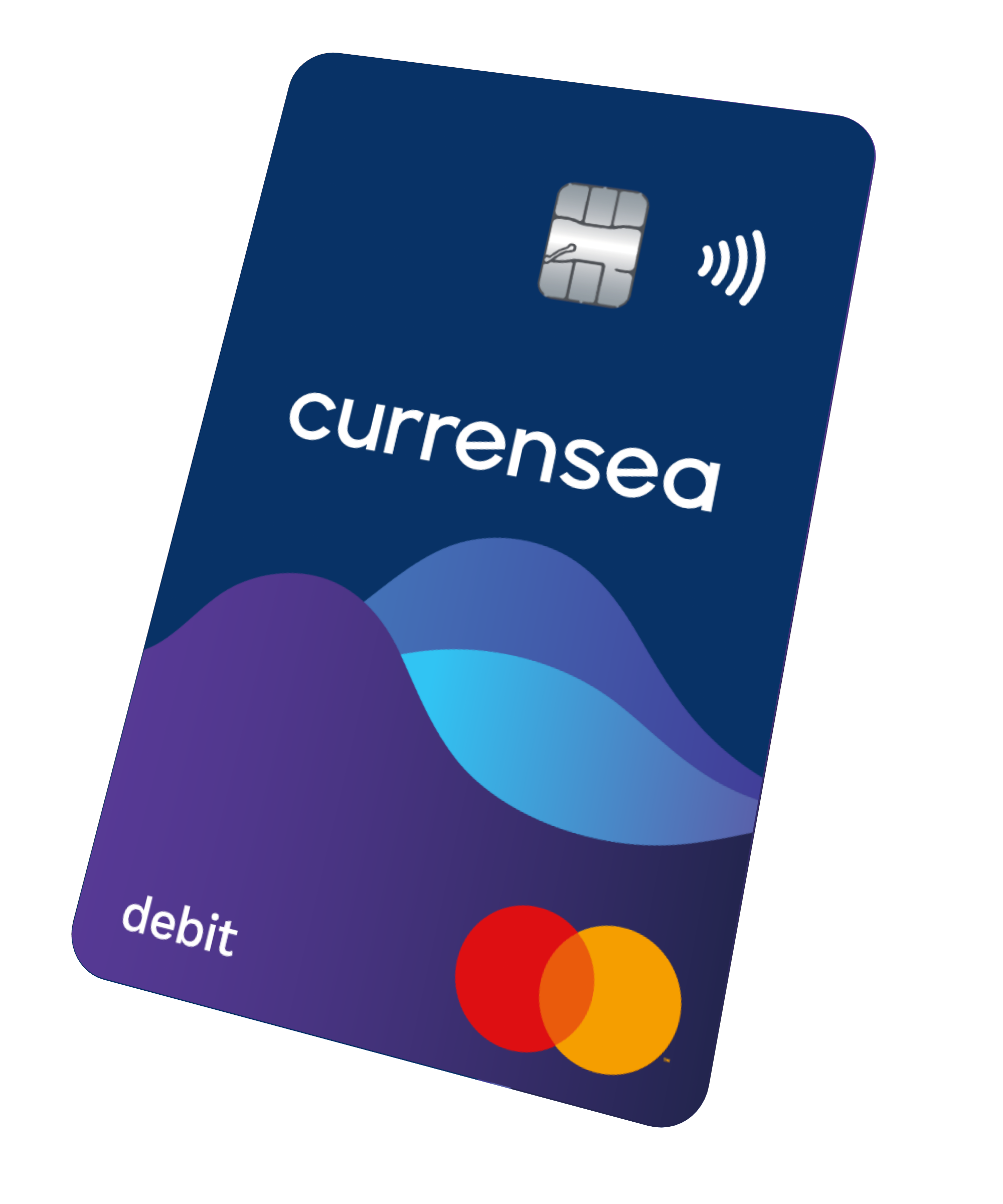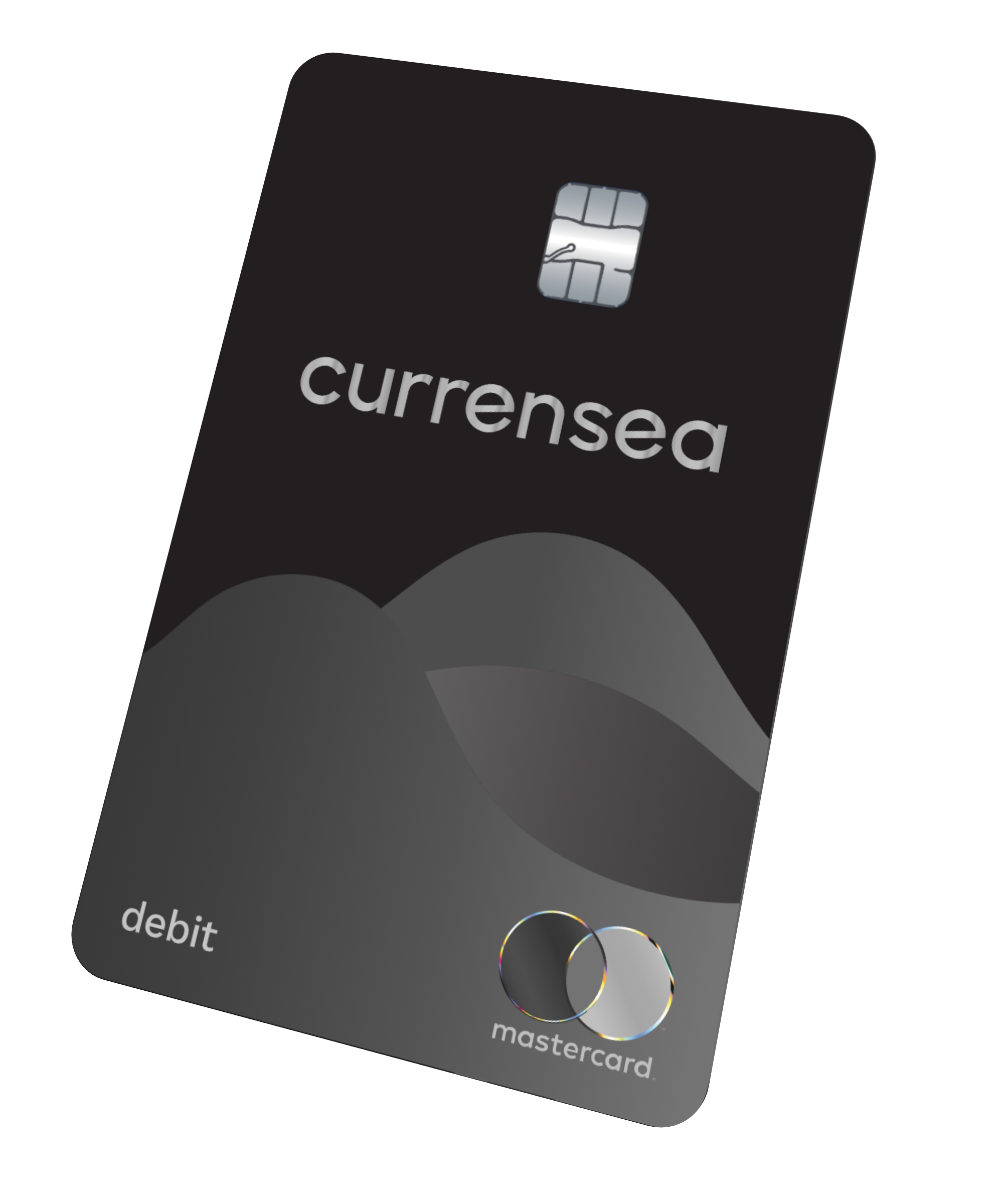The UK’s top rated travel debit card
Currensea connects securely to your bank account - save on FX fees with no top-ups and no hassle.

.gif?width=500&height=500&name=PAYING-cut%20(1).gif)
Make topping up a thing of the past
Currensea connects with your UK bank account. Use your Currensea card and we’ll automatically exchange your money as you spend abroad. No need to top up or transfer money between accounts.

Your money deserves more than “fee free”
Our subscription free Essential plan is typically cheaper than so called “fee free” cards, who pass on hidden fees and rates¹. Plus, the savings get even better on our Pro and Elite plan.
.gif?width=500&height=500&name=NOTIFICATIONS%20(1).gif)
Save £55 a year in FX fees²
On average our customers save £55 per year compared to using a high street bank card. You can see how much money you’ve saved in the app.
Choose your plan

Essential
Great rates abroad with zero hassle
Realtime Rate
Great savingsNo weekend fees
No topping up
Immediate spend notifications
Hassle free card spend abroad
No annual fee

Pro
All of Essential with Pro-level upgrades
Pro Rate
Market leadingUnlimited fee free card spend
£500 fee free ATM / month
All for an annual fee of £39.95
Exclusive Pro Perks
3 x 1GB global data (worth £20)
Avis Preferred Plus
Hertz Gold Plus Rewards
HoteLux Elite (worth £260)
Preferred Hotels
Booking.com 10% cashback
Heathrow Express discounts
Easyjet Plus discounts

Elite
Everything in Pro with luxury upgrades
Pro Rate
Market leadingUnlimited fee free card spend
£750 fee free ATM / month
All for an annual fee of £150.00
Exclusive Elite Perks
5 X 1GB global data (worth £35)
Avis Presidents Club
Hertz Presidents Club
HoteLux Elite (worth £260)
Preferred Hotels
Booking.com 10% cashback
Ten lifestyle management
Luxury Hotels and Resorts
Airport lounge access with LoungeKey
Heathrow Express discounts
Easyjet Plus discounts

Essential

Pro

Elite
Great rates abroad with zero hassle
Realtime Rate
Great savingsNo weekend fees
No topping up
Immediate spend notifications
Hassle free card spend abroad
No annual fee
Not sure which plan is best for you?
Savings calculated on the average amount saved by using a Currensea card abroad vs 14 competitors. Find out more here
Travel like a Pro with Currensea Pro
Get the best FX rate in the market with the Currensea Pro Rate, typically over 0.5% cheaper than “fee free” cards and over 3% cheaper than high street banks³.
It's packed with Pro-level perks, like 3GB of global data, as well as car hire and hotel upgrades.

How Currensea saves you money
Download the app and link your bank account with Currensea
Spend abroad using your Currensea card
We’ll take funds a few days later
Works with your existing bank account

Secure for your peace of mind
Securely connects with your bank account
Covered by Mastercard purchase protection
Freeze your card in the app if it’s lost or stolen
Protect your account with 2-factor authentication and location
Set card spend limits to protect against misuse from fraud and theft
Our dedicated customer service
team is on hand to help
What do the experts say?
“The beauty is, you don't have to worry about pre-loading before you set off”
What do the experts say?
“I am hooked on my Currensea card whenever I go away on holiday.” – Martyn James
What do the experts say?
“Currensea… could be an alternative for anyone who doesn't have the time or doesn't want to set up a fee-free bank account.”
What do the experts say?
“The Sun’s Travel Editor recommends Currensea" - Lisa Minot


£0
Thats how much we’ve saved our customers on high street bank FX fees⁴. Join the FX fee revolution and see how much you can save.
Never forget your Currensea card with Apple Pay


Giving back to reduce the environmental impact of travel

600,000 trees planted
Our customers have planted over 600,000⁵ trees by choosing to contribute a small portion of their bank fee savings to Eden Reforestation Projects.

16 million plastic bottles recovered
By opting to donate some of their bank fee savings to Plastic Bank, our customers have recovered over 16 million ocean bound plastic bottles⁵.

Download the app to get started
Scan with your phone camera to get the app
¹High street banks like Barclays, Lloyds, and HSBC add FX markups to overseas transactions, making the Currensea Realtime Rate significantly cheaper. Challenger banks like Monzo, Starling, and Chase rely on card scheme rates, which are fixed daily, making the Realtime Rate typically cheaper. Additionally, some cards, like Revolut, charge variable fees on weekends and bank holidays.
²Average annual savings are based on customers who made at least one transaction in their first year. We compared FX fees from using their bank card vs Currensea to create an average. More details on our calculation method can be found here.
³The Currensea Pro Rate provides Pro customers access to the interbank foreign exchange rate across 16 major currencies. There are no fees, spreads, markups, or hidden charges applied, ensuring rates superior to those offered by challenger banks, high street banks, travel debit cards, and bureaux de change. For currencies outside these 16, the Mastercard card scheme rate is applied with no spreads, markups, or hidden charges from Currensea. Additionally, there are no extra costs such as weekend fees, bank holiday fees, or dormancy fees. The only cost is your annual membership fee, payable upon renewal. For live exchange rates, visit our Rates Page. For details on how comparisons are made, please see here.
⁴Total savings for 2024 were calculated by comparing the typical FX fees customers would have paid using high street banks vs their use of Currensea.
⁵We partner with Eden Reforestation Projects and Plastic Bank to offset our carbon footprint. Customers can opt to contribute their bank fee savings. Figures represent total contributions since Currensea's launch.
Download the app to get your card
Link to your bank
Connect your Currensea card to your existing bank account.
Spend and save on FX fees
We debit your bank account when you spend, and will notify you of savings.




